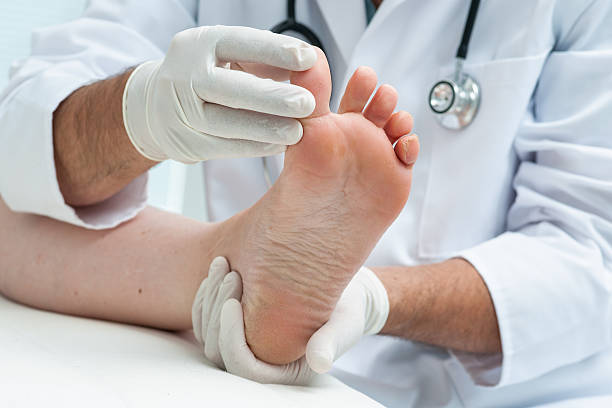Understanding Fungal Infections and Skin Conditions

A fungal infection can be caused by an overgrowth of fungus that naturally lives on our bodies. Certain medications like steroids and cancer treatments can weaken your immune system, allowing fungi to thrive.
Understanding the intricacies of foot health is crucial for maintaining overall well-being. Among the array of conditions that can afflict the feet, heel pain, shin splints, neuromas, and ingrown toenails are prevalent issues that can cause discomfort and hinder daily activities. From the common causes of heel pain to the preventive measures against fungal infections, this article delves into various foot ailments, their symptoms, and strategies for effective management. Whether it’s identifying the signs of fungal infections or learning preventive techniques for ingrown toenails, this exploration aims to empower readers with the knowledge to better care for their feet and mitigate potential issues.
Heel Pain
Heel pain is caused by a variety of conditions. Most commonly, it occurs when a ligament that supports the arch of the foot becomes irritated and inflamed. It is called plantar fasciitis. The condition causes stabbing pain on the bottom of the heel that is most often felt when taking your first steps out of bed or after prolonged sitting. It usually decreases after you start walking and standing, but can return with activity.
Other causes of heel pain include a stress fracture or arthritis, which is inflammation of the joint that connects the knee to the foot. Arthritis in the heel can also cause bone spurs, which are bony growth on the heel bone. It is important to seek treatment for heel pain if it persists.
Another condition that can cause heel pain is a problem with the Achilles tendon, which runs from the calf muscle to the back of the heel. It is prone to injury due to repetitive activity and high-impact sports such as running or basketball. The overuse of the Achilles tendon can lead to a condition called tendinitis, which can cause pain, swelling, and stiffness in the back of the heel. There is also a condition called bursitis, which causes painful swelling in the fluid-filled sacs (bursae) that cushion joints where there is friction or pressure.
Shin Splints
Fungi (yeast and molds) live everywhere, including in your skin and hair. Most fungi don’t cause infections in healthy people. But they can get out of control and spread to other parts of your body, such as the nails or the bloodstream.
Fungal infections can be itchy and embarrassing, but they’re rarely serious. Most infections are caused by fungi like athlete’s foot, jock itch, or ringworm, which affect the skin. Other infections are caused by fungi that affect the nails, such as fungal toenail infection (onychomycosis) or a fungus in the hair called tinea capitis.
Fungal infection symptoms include itching, a rash, or blisters. They usually occur in areas that don’t get much airflow, such as the feet, groin, or folds of the skin. Fungi thrive in warm, moist environments and can become more widespread when the normal balances of fungi are disrupted.
Your GP may refer you to a specialist doctor called a dermatologist if you have a severe infection, a very long-lasting one, or an ongoing problem with infections. You can help prevent infections by washing and drying your skin well after showering, especially in areas that don’t receive much airflow. Avoid walking barefoot in communal areas such as locker rooms and swimming pools. Wear loose-fitting clothes made from cotton or breathable materials, and wear proper footwear for your activities.
Neuromas
Fungi are a type of organism that can cause infections in a variety of ways. They can live outdoors in soil or on plants, indoors on surfaces or in the air, or even inside the body (mouth, intestines, and lungs). Fungi are everywhere and there are millions of them, but only a few hundred of these organisms are known to make people sick. Fungi grow by releasing tiny spores into the air. These spores can land on other people or in damp public places, such as showers and locker rooms. Fungi that are found on the skin, like athlete’s foot and jock itch, are called superficial because they usually don’t penetrate the skin and enter the bloodstream.
More serious fungal infections are more difficult to diagnose and treat. For example, some types of fungal infections in the nails aren’t visible to the naked eye, and they can be difficult to distinguish from other types of nail diseases. A podiatrist High Wycombe may need to take a sample of the infection and send it for lab testing.
To help prevent fungal infections, dry your feet well after washing them and avoid walking barefoot in areas where fungi thrive, such as in communal showers or public pools. You can also reduce your risk by wearing shoes made of breathable materials and avoiding tight-fitting shoes.
Ingrown Toenails
An ingrown toenail is a painful condition that can develop into an infection. Symptoms include redness, swelling, and pain at the side of the nail near the cuticle. You may also notice new, inflamed tissue that looks like tiny granules and weeps or produces pus. This is called a granuloma.
Ingrown toenails can often be treated with home remedies. However, if your symptoms are severe or you have a chronic condition that affects the feet or lower legs, including diabetes or circulatory problems, it’s important to seek medical treatment.
Your podiatrist Guildford provider will diagnose ingrown toenails based on your symptoms and physical examination. They might also take a sample of the toenail if they think you have an infection. In some cases, they may take a culture and/or X-rays to identify the cause of your infection.
To prevent ingrown toenails, trim your toenails straight across with a sharp nail clipper and avoid rounding or tapering the corners. Wear shoes with plenty of room for your toes, and change socks regularly. Soak your feet in warm, soapy water to soften the toenails before trimming. If you have a chronic problem, a podiatrist might suggest a nail splint to lift the ingrown nail edge and help it grow above the skin’s edge. They might also numb your toe and surgically remove part of the ingrown nail.
Maintaining healthy feet involves understanding the various conditions that can affect them, including fungal infections and other skin ailments. From heel pain to ingrown toenails, each issue presents its own set of challenges, but with awareness and proactive care, many of these problems can be managed effectively. Whether it’s practicing good hygiene habits, wearing appropriate footwear, or seeking professional medical assistance when needed, taking steps to address foot health can greatly improve overall well-being. By staying informed and attentive to the needs of our feet, we can ensure they continue to support us in our daily activities without unnecessary discomfort or complications.

